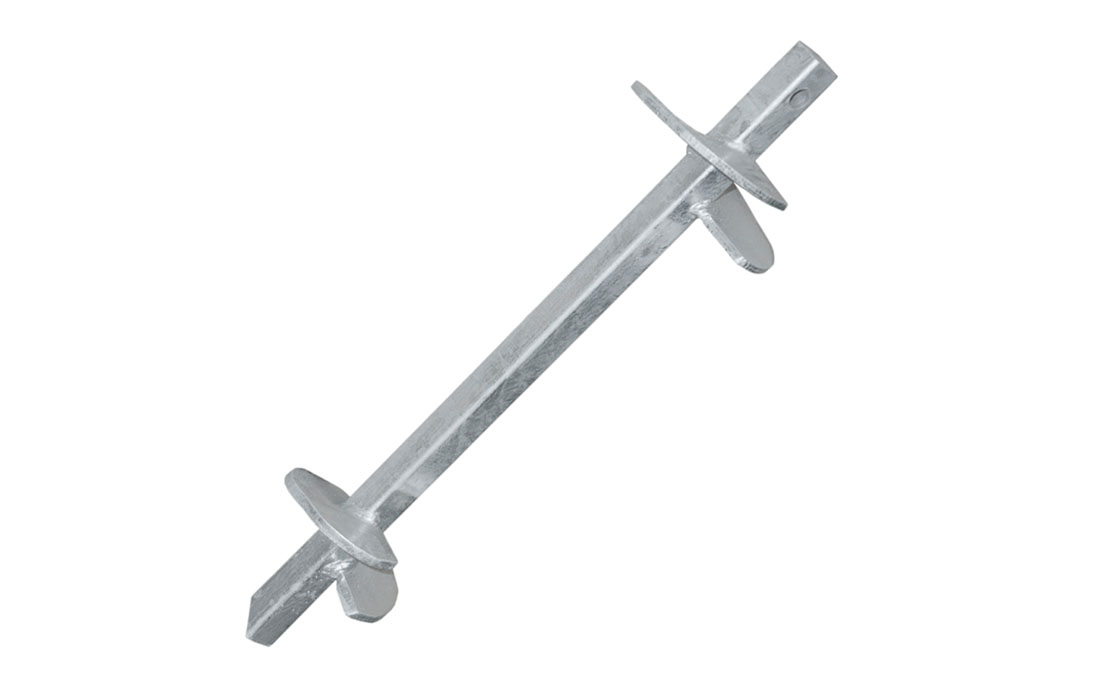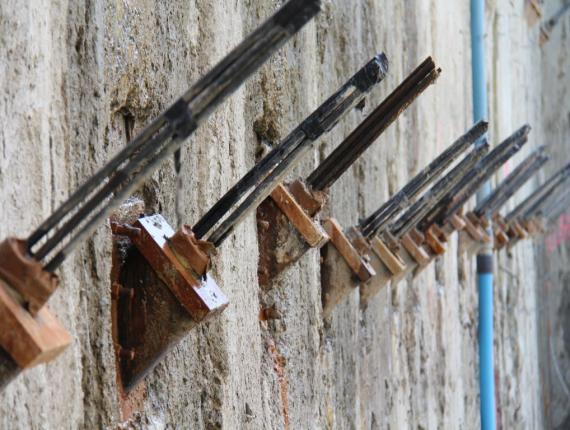How Durable Earth Anchors Work: A Comprehensive Overview to Soil Anchoring Solutions
Sturdy Earth anchors play a crucial role in supplying stability and assistance in numerous building applications. By embedding deeply right into the ground, they stand up to upright and lateral pressures successfully. Various types of supports provide to different dirt conditions, making them versatile. Understanding their technicians and installation strategies is necessary for making the most of efficiency. What variables influence their performance, and just how do they contrast to typical approaches? The solutions may stun you.
Understanding Durable Earth Anchors
Sturdy Earth supports function as essential components in numerous construction and landscape design tasks, providing stability and support in difficult dirt problems. These supports function by being installed into the ground, where they stand up to upright and lateral forces. Their layout permits safe attachment to structures, ensuring they remain anchored against soil activity or exterior loads.The efficiency of durable Earth supports largely depends upon the sort of soil and the anchor's installment deepness. Appropriate installment strategies are vital, as they establish the support's holding ability. Ecological variables, such as moisture and freeze-thaw cycles, can also impact performance.These anchors are frequently utilized in applications varying from securing fencings and preserving walls to supporting short-lived structures throughout adverse weather conditions. Comprehending the principles behind heavy-duty Earth anchors is essential for professionals looking for to boost the durability and safety of their projects.
Kinds of Heavy-Duty Earth Anchors
Different sorts of sturdy Earth supports are made to fulfill details needs based on soil problems and job needs. Helical supports, including screw-like blades, are effective in softer dirts, providing high load capabilities and easy installment. Driven anchors, which are hammered into the ground, appropriate for rocky terrains and provide prompt tons assistance. Tie-back supports are typically used in preserving wall surface applications, permitting lateral assistance by anchoring right into the ground at an angle. Another kind is the cast-in-place anchor, perfect for concrete applications, as they are integrated right into foundations for improved security. Soil screw anchors are versatile choices that can be made use of in different soil types, supplying reputable tension and compression abilities. Each type offers unique applications, ensuring stability and safety in construction and landscape design projects. Comprehending these choices enables educated decisions in choosing the appropriate Earth anchoring option.
The Mechanics of Dirt Anchoring

Understanding the technicians of dirt anchoring requires an assessment of various kinds of Earth supports and their installment strategies. Each support kind offers distinct features that influence its performance in different soil conditions. Correct installment techniques are necessary for taking full advantage of the anchoring system's security and efficiency.
Kinds Of Earth Anchors
Earth supports, crucial elements in soil anchoring systems, come in a number of kinds, each made for details applications and dirt conditions. One of the most usual types consist of screw anchors, which are turned right into the ground, supplying strong lateral resistance. Helical anchors include blades that permit reliable setup in various soil types, making them appropriate for both momentary and irreversible applications. Driven anchors, generally made from steel, are inculcated the soil and work in rough or dense atmospheres. Auger anchors use a helical style to assist in setup in softer dirts. Plate anchors consist of a flat plate buried horizontally, dispersing tons over a larger location, suitable for applications requiring high lots capabilities in cohesive dirts.
Installation Strategies Clarified
Appropriate installation strategies are crucial for the efficiency of dirt anchoring systems. The procedure commonly begins with site assessment, confirming the chosen location can support the support's load. After determining the right support type, correct hole deepness and angle should be developed. The setup includes driving the anchor right into the ground utilizing specialized devices, such as manual or hydraulic drivers, to achieve finest embedment. Post-installation, tensioning the anchor is vital to guarantee security; this is commonly confirmed with load testing. Additionally, surrounding soil conditions ought to be kept an eye on to stop displacement. Following these methods not just boosts the anchor's efficiency however also prolongs its lifespan, providing trustworthy assistance for numerous applications.
Applications of Heavy-Duty Earth Anchors
While sturdy Earth supports are usually related to building and landscape design, their convenience encompasses a selection of applications throughout various industries. In civil engineering, they offer important assistance for retaining walls, making certain stability in locations vulnerable to soil erosion. The aquatic industry uses these supports for securing anchors and marinas, preventing motion brought on by tides and currents. In addition, in the telecom sector, heavy-duty Earth anchors are considerable for supporting cell towers and other high frameworks against wind forces. Agricultural applications additionally benefit, as these supports can secure structures like greenhouses and livestock fence, guaranteeing they hold up against rough climate condition. Furthermore, in eco-friendly energy jobs, such as wind ranches, Earth supports play a vital function in dig this safeguarding turbine structures, improving general safety and performance. This broad range of applications highlights the adaptability and integrity of heavy-duty Earth supports throughout various areas.
Advantages Over Typical Anchoring Methods
Although traditional anchoring approaches have long been counted upon for security, sturdy Earth supports offer significant advantages that enhance performance and effectiveness. One major benefit is their remarkable load-bearing capacity, which permits them to stand up to better forces without failing. This strength makes them suitable for requiring applications, such as in building and utility installations.Additionally, durable Earth anchors are made for deeper setup, supplying greater security in different dirt problems, consisting of loose or sandy soils. Their resistance to rust and ecological variables guarantees a longer life expectancy and minimized maintenance expenses compared to conventional methods.Moreover, these supports can be installed with minimal disruption to the surrounding area, protecting the honesty of the landscape. Generally, sturdy Earth anchors offer a trusted and efficient remedy for securing needs, surpassing the restrictions commonly connected with traditional anchoring techniques.
Installment Refine and Finest Practices
The installment procedure for soil anchoring options starts with detailed preparation and site assessment to guarantee peak performance. Following this, a detailed setup guide gives clear guidelines for effective implementation (heavy-duty earth anchors). Sticking to these ideal techniques is vital for achieving reputable and resilient anchoring results
Prep Work and Website Evaluation
Reliable prep work and extensive site analysis are essential actions in the installation of dirt securing remedies. Prior to setup, the soil type should be evaluated to establish its bearing ability and viability for securing. Carrying out a geotechnical survey can give essential info about soil make-up, wetness degrees, and prospective ground activity. Furthermore, determining existing structures, vegetation, and utilities is important to prevent interference during installment. The area should be free from particles and obstacles to ensure safe gain access to for equipment. Climate condition need to also be checked, as unfavorable problems can impact both safety and security and setup efficiency. By carefully preparing the site and evaluating all relevant variables, the probability of effective support performance is significantly enhanced.
Step-by-Step Installment Guide
An extensive installation procedure is crucial for accomplishing ideal efficiency of soil securing options. The setup starts with selecting the suitable anchor kind and ensuring the website is free from debris. Next, proper opening placement is identified based upon tons demands. Once the location is established, holes are pierced to the defined deepness and size utilizing the right tools. The anchor is after that placed right into the opening, seeing to it it is lined up appropriately. After securing the anchor, soil is backfilled and compacted to improve security. It is vital to comply with producer standards throughout the process. A post-installation inspection validates that the supports are properly located and working as intended, providing dependable assistance for the desired application.

Upkeep and Evaluation of Earth Anchors
Normal upkeep and inspection of Earth supports are important for making certain long-lasting performance and stability. dig this Periodic checks enable for the very early discovery of concerns such as corrosion, loosening up, or dirt movement. Inspectors need to seek indications of corrosion or destruction on the anchor parts, especially at the link factors. In addition, the surrounding soil should be analyzed for disintegration or adjustments in wetness material, which can affect anchor effectiveness.It is advisable to develop a regular examination schedule, ideally a minimum of yearly, relying on environmental conditions. During assessments, all visible components must be cleaned to remove dust or particles that might conceal prospective problems. Any type of indicators of distress, such as tilting frameworks or uncommon settling, should prompt instant assessment. Appropriate paperwork of assessments can aid in tracking support efficiency with time and facilitate timely upkeep actions, guaranteeing the anchors remain dependable and functional.
Often Asked Concerns
What Products Are Heavy-Duty Earth Anchors Commonly Made From?
Sturdy Earth anchors are generally built from resilient products such as galvanized steel or stainless-steel, making sure strength and resistance to rust. These materials give lasting support and stability in various soil problems and applications.
How Do Dirt Problems Impact Support Performance?
Soil conditions greatly influence support performance. Elements such as dirt type, dampness material, and compaction influence the anchor's grasp and security, with cohesive dirts commonly offering far better resistance than sandy or loosened soils, impacting total effectiveness.
Can Heavy-Duty Earth Anchors Be Reused After Removal?
Durable Earth anchors can be recycled after removal, given they are inspected for damage and wear. Proper cleansing and maintenance enhance their long life, making sure reliable performance in succeeding installations when conditions permit risk-free reinstallation.
What Are the Ecological Effects of Making Use Of Earth Anchors?
The ecological impacts of using Earth supports include prospective soil disturbance, interruption of regional environments, and feasible contamination of groundwater. Nonetheless, if used properly, their advantages typically outweigh these concerns, promoting security in different applications.
Exactly how Do I Select the Right Support for My Task?
